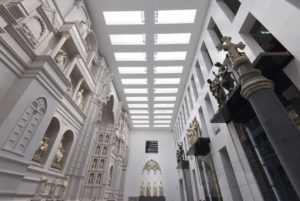 Almost two years after its renovation and reopening, the Museo dell’Opera del Duomo in Florence is employing a creative strategy to attract visitors. Drawing upon an idea put forth by its director, Monsignor Timothy Verdon, the museum is looking at religious artworks in a re-created religious environment, exploring the messaging that motivated artists in a way that both religious and nonreligious visitors will appreciate.
Almost two years after its renovation and reopening, the Museo dell’Opera del Duomo in Florence is employing a creative strategy to attract visitors. Drawing upon an idea put forth by its director, Monsignor Timothy Verdon, the museum is looking at religious artworks in a re-created religious environment, exploring the messaging that motivated artists in a way that both religious and nonreligious visitors will appreciate.
The Museo dell’Opera del Duomo was built in 1891 behind the city’s most famous cathedral to house medieval and Renaissance sculptures and other works created for the Duomo. It reopened in October 2015 after a three-year, 50€ million renovation. Since then, the museum has quadrupled its attendance, and visitors spend more time inside than before – about two hours – indicating that Verdon’s vision is a success.
“I was convinced that [the museum’s displays and texts] were the only way to let the works rediscover their own voice and say what they meant to say,” Verdon told The National Post. “In the 2,700 years of Western art, art made for temples or churches, the artists were communicating to people for whom the message was existential, not intellectual. You have to find a way to let people today into the messages in order to be fair to the artists.”
Verdon is a New Jersey native who earned a doctoral degree in art history before becoming a priest and moving to Italy. He envisioned setting the artworks in a religious context to show visitors the religious motivations of the great masters, but he says anticlericalism in Europe made that difficult to achieve.
“For a long time, art historians thought you could only discuss art values and leave the religious meaning to the theologians,” he said. Verdon finally convinced the museum’s board to implement his vision in 2011, and the renovation began in 2012.
In Verdon’s version of the museum, in the entry atrium are a replica of the Duomo’s Gothic façade with several statues, and the original bronze doors by Lorenzo Ghiberti that outfitted the Duomo’s baptistery. A placard in the atrium explains the religious setting, saying, “Christians call the area between a Baptistery and its related church a Paradiso, evoking the joy of those who, after receiving baptism, cross that space to participate in the Eucharist for the first time.”
The upper floor contains vestments, liturgical objects, and choir lofts created in the 15th century by Donatello and Lucca della Robbia. To mimic the sacred experience worshipers would have experienced in the space, the ceiling depicts 15th-century frescoes, and religious music plays.
Religious art and sculpture is also on display, including a life-sized wooden carved Mary Magdalene by Donatello, and a version of the Pieta by Michelangelo that the artist intended to have put in his own tomb. However, Michelangelo destroyed part of the piece because of flaws in the marble used to carve it; after Cosimo I de Medici put it back together and had it put in the San Lorenzo Basilica’s Medici Crypt, it was given to the Duomo.
By Kathy McCabe
